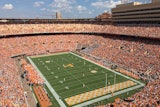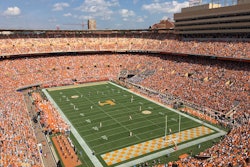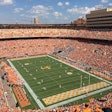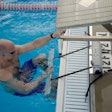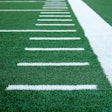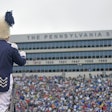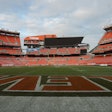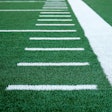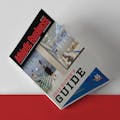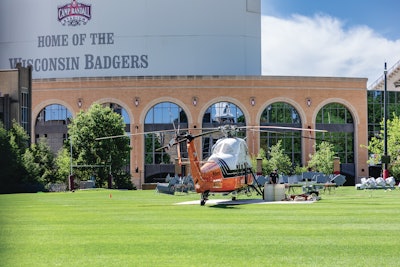
The University of Wisconsin’s Camp Randall Stadium is the rare 80,000-seat collegiate football venue that abuts a densely populated residential area. Located quite literally across the street from what’s considered the leading edge of Madison’s near west side, the stadium became the site of a neighborly act this spring when the UW athletic department opted to use a helicopter to remove existing HID field lighting and replace it with a state-of-the-art LED system.
With Camp Randall’s westside upper deck shrouding the two-way street beneath it in morning shadows, the retrofit’s heavy lifting was completed May 16 within a matter of hours. Such expediency would have been impossible had UW cordoned off the street, Breese Terrace, and employed a traditional crane to maneuver the lighting components.
“The alternative was that we were going to have to close Breese Terrace for up to a week to install the lights that are on that side, on the press box,” says Jason King, Wisconsin’s senior associate athletic director for capital projects and operations. “And then the other side of the stadium was going to be a challenge because we have a new indoor practice facility we’re building right now, and there’s a lot of construction on that side. So, when they told us that they could have all the work done between 7 a.m. and noon, I was, frankly, a bit dumbfounded. I was a little skeptical. But I’ll be damned. They did it.”
They, in this case, was a crew from Midwest Helicopter Airways Inc., which made the hour-long flight north from Willowbrook, Ill. In business since the late 1960s, tackling everything from rooftop air conditioning installation and communication tower assembly to forest fire fighting and Haitian earthquake relief, Midwest has lifted more stadium lighting systems into place than any other aerial crane service in the United States.
“We don’t look at every job. We tend to look at jobs that are more logistically challenging or higher profile,” says Jim Triggs, director of operations at Midwest, which handled Wrigley Field’s first-ever lighting installation in 1988, as well as its subsequent updates. “With the stadium stuff, there’s obviously a unique dynamic to it. I drove up [to Madison] about a month or so in advance to walk the site, and we went through all the different scenarios. We went up and inspected the old light fixtures and then the areas that we were going to put the new light fixtures to develop a plan of action, not only with the university, but with the city and then the final authority — the FAA.”
Nuts and bolts of aerial installation
The Camp Randall job involved designating an outdoor football practice field to the immediate north of the stadium as a staging area. The new lights were positioned there, ready for pickup once the helicopter had removed sections of the existing HID lighting. A round trip takes only “two to three minutes from the time we pick it up and set it to the time we’re back to get another one,” according to Triggs, who adds, “The first few lifts don’t go as fast because the pilot is getting used to the environment, the signalmen are getting used to their crew, and their crew is getting used to us. And, you know, once the nostalgia of ‘Hey, there’s a helicopter over here’ kind of wears off, now they start focusing more on what they have to do.”
Positioning sections of lighting — in Camp Randall’s case, they ranged from stacked arrays of nine fixtures each on the press box to linear groups of four fixtures along the roof of the stadium’s eastside suites — is a process that requires teamwork and precision. Imagine lining up bolt holes on hardware as it’s maneuvered by the pilot of a helicopter on the upper end of a so-called “long line” measuring 100 feet.
“We have a representative from our team at the lift site down on the ground and at the set site up on the roof, and they’re communicating those finer details,” says Triggs, himself a pilot, just not on this installation. “The pilot is leaning out of the aircraft so he can see what’s going on, and we correlate what our visual cues are and the feel of what the aircraft is doing with what our signalmen are saying. They’ll call us in: ‘Hey, you’re 10 foot up,’ or, ‘You’re five foot up.’ We’ll listen to how fast they’re counting, and that kind of gives us an idea of how fast we’re descending or coming into them. They’ll give us those kinds of cues and let us know what they need, and then we just compensate and work together.”
Some compensation was required early in the UW installation, as the team discovered bolt holes weren’t aligning perfectly. “They came up with an alternative plan and secured some of those fixtures with a ratchet strap, so there was no ability for that piece to come loose. It was attached to the building, and then they were able to make bolt holes afterward,” Triggs says, before describing the more typical scenario. “On the T-frames on the east side of the stadium, there are four bolt holes that have to be met. When we get lined up, they get a couple of bolts initially started, then crank those nuts and bolts down so they’re tight.”
Adds King, “Once they got going, it was like clockwork.”
Naturally, all of this happened at the whim of current weather conditions. According to Triggs, winds blowing over the northern rim of Camp Randall Stadium made the pickup process particularly challenging.
“For this job, winds were a big factor. We were pretty much at the threshold for the winds that we would want to operate in,” he says. “Just to kind of put it in simple terms, airplanes like to take off into the wind — reason being, it generates more lift over the wings. We’re much the same. On calm days, we can still fly. We can still do the job, but it’s more work that the aircraft has to do. Having a breeze is a little easier on the aircraft. However, if you’re trying to hold a load within a few inches and the wind’s going from, say, 10 miles per hour to 20 and then back down to 10 again, we have to compensate for that. You have a lot of up and down. If that drops down, now you have to compensate for that loss of air flow over the rotor blades.”
Is it all enough to reconsider traditional grounded cranes? “Cranes definitely have their place — there’s no doubt about that — but it comes down to some logistical things,” Triggs says. “With Camp Randall, that whole road would be blocked off for days and days and days. For our assignment, it was just a fraction. And instead of having all these loads spread throughout the site because the crane can only reach so far, they were able to centralize all the loads in one location.”
Moreover, opting for aerial crane installation doesn’t necessarily require greater investment. “There’s a lot of scenarios where it ends up being cheaper,” says Triggs, who estimates that Midwest’s three Sikorksy S-58T helicopters, each capable of lifting 4,500-pound loads, combined to move more than 7,500 tons of material in 2024. “Customers are saving on the labor hours. Where a crane might take two, three days or even longer, we’re only there for a few hours.”
Fans, media, neighbors
During the first week of June, the UW athletic department shared video of the installation on social media with the tease “something big is coming to Camp Randall.”
“We’re excited that we’re going to be able to provide a better experience in-stadium for not only broadcast, but for our fans,” says King, whose office windows afforded him a bird’s-eye view of the $1.64 million project — the cost figure including the 185 Musco Lighting fixtures and the aerial installation. “There’s much more even coverage throughout the stadium, which I think will provide a better fan experience and provide a better media experience, as well.”
King says the enhanced fan experience will include the kind of special effects for which LED stadium lighting has become known. “They call them scenes, and we’ll have an array of different scenes that we can use on gameday, if we choose,” he says. “Now, there are some regulations that we have through the Big Ten on when we can and can’t use scenes, based on broadcasts. But, yes, we will have the ability to do that, and we’ll take advantage of that at different points. I think there are 47 lamps that are specific color-tuned lamps that will allow us to, for example, turn the stadium red — things that we didn’t have the ability to do previously.”
Now installed with minimal civic disruption, the lighting upgrade will show additional consideration for Camp Randall’s neighbors when in use this fall.
“We’re upgrading our foot-candles from 150 to 180 now, and there will be significantly more even coverage throughout the stadium with the new system, without any additional spillage” of light from the stadium into homes and yards, according to King.
“Our football facility is in a neighborhood,” he says, “so that’s a big deal for us.”
















